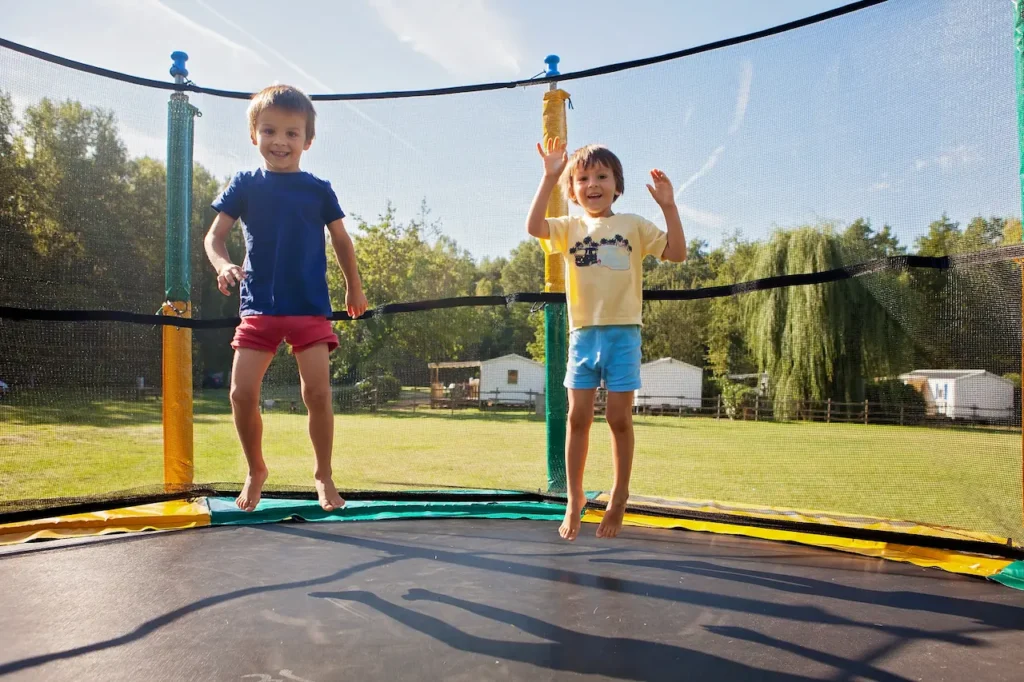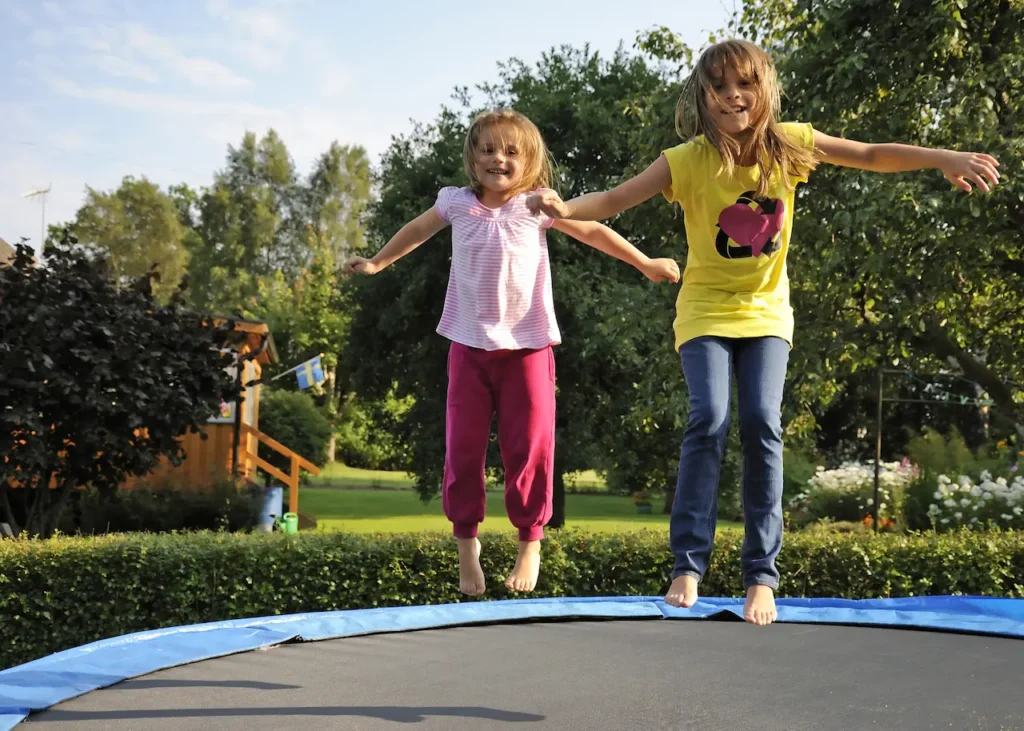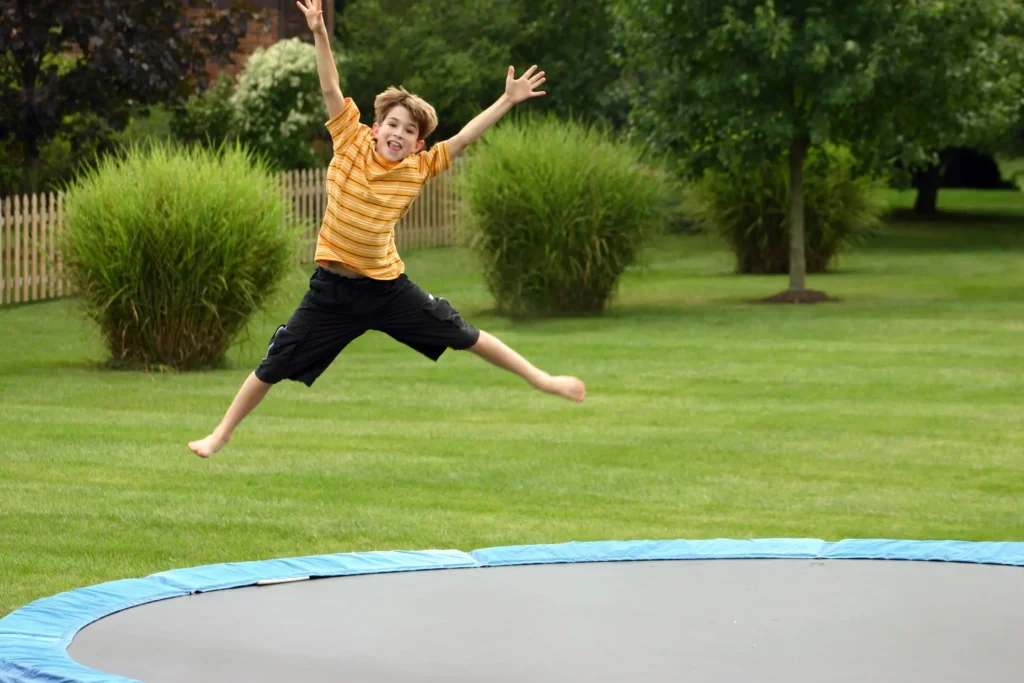Trampolines and Kids
Understanding the Hidden Dangers of Trampolines and How to Keep Your Kids Safe
Trampoline Parks are great for a fun day with the family. They offer a healthy, active environment. The combination of trampolines and kids can be a fun and exciting experience. However, behind the laughter, and the bouncy fun there are growing concerns about the safety and security of the trampoline park, particularly regarding injuries sustained by adults and children. Professor and biomechanical engineer has warned of the dangers associated with trampoline parks. His research and studies highlight hidden dangers that can lead to serious injuries. He compares trampoline parks’ force transfer to “being hit with a heavy hammer.”
Pidcoe’s alarming remarks are the result of extensive research into the mechanics of jumping. This research reveals that trampoline parks create an unpredictable, dangerous environment for children and other jumpers. Even in controlled environments, injuries are more likely due to the interconnected trampolines and the physical forces that they generate. Pidcoe’s warning is a reminder to take safety precautions when visiting trampoline parks. They may seem harmless and safe, but they can be deadly if not done properly.
This article will discuss Pidcoe’s findings and the hidden dangers of trampoline parks to children. It will also explain the physics behind trampoline injury and what parents can do to reduce the risk.

Physics Behind Trampoline Parks
Understanding trampoline park physics is crucial to understanding why injuries occur so often. Pidcoe’s six-year research into trampoline park dynamics revealed that these parks’ interconnected beds are one large bouncing surface. Jumpers can’t predict the height of their bounces or where they will land next because energy is transferred between trampolines.
Pidcoe, in an interview with CBS News, explained that the trampoline surface changes height. It’s like walking on a step that isn’t even there. This unpredictable nature can cause serious injuries. The trampolines bounce back in response to the jump of a person, but the fact that they are connected creates an unstable situation. Movement on one trampoline can transfer to the other trampoline.
The jumper can lose control and make uncontrollable jumps. This can cause collisions, falls, or even bone-breaking injuries.
Trampolines and KidsA seemingly innocent bounce can cause a jumper to be propelled higher than they anticipated or land in an unexpected place, making them prone to injury when they hit the surface or collide with other jumpers. The bounce of a seemingly innocent jump can propel a jumper higher than anticipated or land them in an unexpected location. This makes them more susceptible to injury when they collide with the surface or other jumpers.
Major Risk Factors of Double Bouncing
The “double bounce” can be one of the most dangerous situations in a trampoline park. This happens when two people jump on adjacent trampolines, and the force from one jumper is transmitted to another. The second person can be propelled higher and lose control if the force of one jumper is transferred to another. This extra height may cause the trampoline to be hit harder by the jumper, leading to injuries such as fractures, sprains, and head trauma. This situation is especially dangerous in an environment with multiple people bouncing simultaneously.
According to research, trampoline parks were designed so that double-bounce situations are more likely. Trampolines can sometimes be arranged in a way that the energy from one jumper is transferred to those nearby, causing someone to go much higher than they intended. It can be nearly impossible to gain control. The more they are propelled up, the harder the trampoline will strike them, increasing the risk of injury. A harmless bounce could turn into a dangerous tumble. The force of the impact can cause serious injury.
This risk is magnified in a crowded trampoline park. The energy transfer between trampolines is unpredictable when multiple people jump nearby. This destabilizes the jumpers and increases the likelihood of a collision. Children are more at risk because of their smaller size and lack of coordination. They are more susceptible to injury because their muscles and bones have not developed as much as adults. Their reflexes are also still developing, making them less likely to react quickly enough to avoid injury.
Dangers of Broken Bones and Spinal Injuries
Many parents mistakenly believe that trampoline park injuries are only sprains and bruises. In reality, trampoline parks may cause much more serious injuries. Pidcoe’s research, as well as reports from trauma surgeons and doctors, highlight a worrying trend: trampoline injuries are not just frequent but often severe.
A trauma doctor in Utah has treated many patients with injuries sustained at trampoline parks, including head trauma, broken legs, and spinal fractures. These injuries are similar to those that occur in high-velocity trauma, such as motorcycle or car crashes. Trampoline park injuries can be comparable to those caused by a 90-mile-per-hour crash.
These serious injuries do not affect only one part of the human body. Spinal injuries are also common when a person falls awkwardly or collides with someone else. Head injuries can also be a serious concern. Falls from trampolines may result in concussions or skull fractures.

Trampoline Parks and Children
Children are the most susceptible group to trampoline injury. They are still growing and have more fragile bones than adults. Children’s small size and developing coordination make them more susceptible to losing control when jumping.
Pidcoe’s warning on the dangers associated with jumping together on trampolines alongside children is an important point. The forces that are involved when an adult or heavier individual jumps onto the trampoline with a child can be devastating. Pidcoe found that transferring energy from a parent to a child who is already on a trampoline can cause the child to be twice as heavy. The force transfer can cause bones to break, as happened when a father accidentally broke his child’s foot while jumping on the trampoline with him. The force applied to the child’s leg was compared to being “hit with a hammer.”
These incidents show the dangers of jumping with others, particularly children. Trampoline parks are designed for multiple people to jump at the same time, but the unpredictable energy transfer makes it more dangerous for children when they are jumping with other children or adults. They simply can’t absorb the force of an adult, so parents should be extra cautious when jumping with their children.
Trampoline Park Injury Surge
Unfortunately, the popularity of trampoline parks has been accompanied by an increase in injuries. The sheer number of children in trampoline parks increases the chance of an accident. A former manager of a trampoline park revealed to a former manager that the center in Brisbane, Australia alone had over 1,100 injuries within a year. Some of these injuries, like sprains and strains, were minor. However, other injuries, like broken bones or spinal injuries, were more serious.
Experts have called for tighter safety regulations at trampoline parks due to the dramatic increase in injuries. In 2017, Dr. Christopher Mulligan from Sydney Children’s Hospital echoed the concerns of the experts, noting a significant increase in children presenting to the emergency room due to trampoline-related injuries. The injuries he observed ranged from minor soft-tissue sprains to serious spinal injuries and bone fractures. Some of the injuries were so severe that surgery was needed.
Experts say that the problem is due to a lack of standard safety regulations for trampoline parks. The majority of trampoline parks self-regulate, which means that there are no universal safety standards to be followed by all parks. The lack of oversight may mean that some trampoline parks do not have safety measures in place for protecting jumpers, putting both children and adults at risk.
The Importance Of Caution
Parents and caregivers should be aware of the risks associated with trampoline parks. Trampoline parks, with their multiple surfaces and unpredictable forces, can create an uncontrollable environment.
Pidcoe and other experts recommend parents exercise extreme caution, especially when their children are jumping on trampolines. Parents should try to avoid jumping on trampolines with their children, as the force exerted by them can increase the likelihood of an injury. Parents should also supervise their children closely to ensure that they do not jump in a manner that could cause a collision or double bounce.
Experts strongly recommend that children younger than six years old avoid trampolines. They are less able to handle the forces of jumping because their bones are fragile. Older children must jump into a controlled, safe environment with plenty of supervision and no overcrowding.
You may also Like: Protecting Your Baby During Coronavirus
Safety Regulations Need to Be Stricter
The need for more stringent safety regulations is increasing as trampoline parks continue to gain popularity. The trampoline industry is currently largely self-regulated. This means that each park sets its safety standards. The lack of consistency in trampoline park safety has increased injuries. Experts are calling on governments to create safety guidelines that will be mandatory for all parks.
Trampoline parks need to implement stricter supervision practices in addition to improved regulations. This includes limiting the number of jumpers per area and giving clearer safety instructions. Parks must also invest in safer trampoline designs with softer surfaces or more protective barriers.

Conclusion
The warning from biomechanical engineer Pete Pidcoe is a good wake-up call to parents and trampoline parks. Trampoline parks are a great way to have fun, but they also pose a significant risk to both children and adults because of the unpredictable forces. Safety is not guaranteed in many trampoline parks due to the lack of regulations. Injuries can be minor or life-threatening.
Parents must be vigilant when they take their children to the trampoline park and should supervise them closely. They should also avoid jumping together. The trampoline park industry must also take responsibility for their safety, implementing stricter regulations and improving supervision to reduce the risk.
Trampolines are a fun way to exercise and have fun, but parents and operators need to be aware of their dangers and take the necessary steps to make sure that everyone is safe. We can prevent injuries by staying informed, following safety guidelines, and supporting laws that place safety first.



